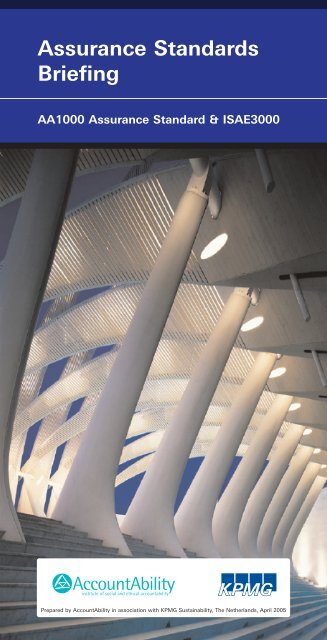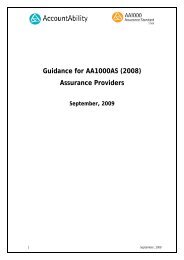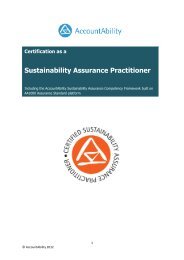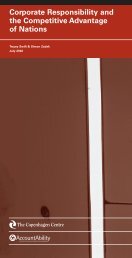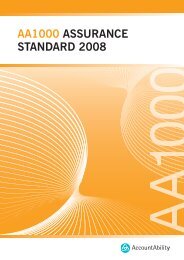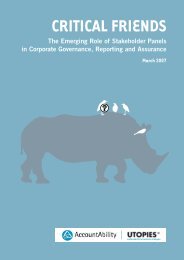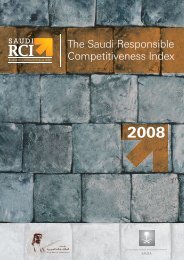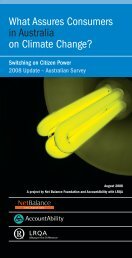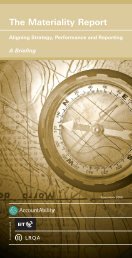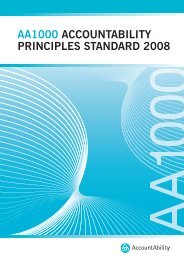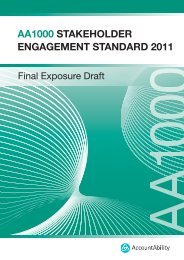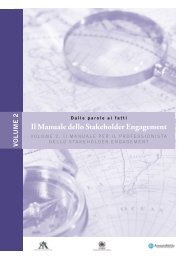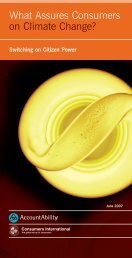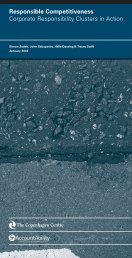Download - AccountAbility
Download - AccountAbility
Download - AccountAbility
Create successful ePaper yourself
Turn your PDF publications into a flip-book with our unique Google optimized e-Paper software.
Assurance Standards<br />
Briefing<br />
AA1000 Assurance Standard & ISAE3000<br />
Prepared by <strong>AccountAbility</strong> in association with KPMG Sustainability, The Netherlands, April 2005
<strong>AccountAbility</strong> and KPMG Sustainability, The Netherlands have partnered<br />
for this research project on Assurance Standards, bringing<br />
together their respective experience as standards developer and<br />
practitioner.<br />
<strong>AccountAbility</strong><br />
As a leading international professional institute, our work includes developing<br />
innovative and effective accountability tools and standards (notably<br />
the AA1000 Series), carrying out cutting-edge strategic research,<br />
exploring best practice for practitioners and policy-makers in organisational<br />
accountability, promoting accountability competencies across the<br />
professions, and promoting an enabling environment in markets and<br />
public bodies.<br />
Core to <strong>AccountAbility</strong> are our members who are drawn from business,<br />
civil society organisations and the public sector worldwide. We embrace<br />
an innovative, multi-stakeholder governance model that allows our<br />
members to govern and support us, as well as play a vital role in shaping<br />
our direction and work.<br />
Unit A, 137 Shepherdess Walk, London, N1 7RQ, UK<br />
Tel: +44 (0)20 7549 0400 / Fax: +44 (0)20 7253 7440<br />
www.accountability.org.uk<br />
KPMG Sustainability, The Netherlands<br />
KPMG Sustainability B.V. is part of KPMG in The Netherlands, with around<br />
30 environmental, social and economic professionals. The group, one of<br />
the first in Europe in this field, has provided audit and advisory services in<br />
the field of sustainability or corporate social responsibility (CSR) for more<br />
than 20 years. Our clients include multinationals in Europe, Asia Pacific<br />
and Latin America, and we have project experience in more than 35 countries.<br />
KPMG Sustainability B.V. is part of KPMG’s Global Sustainability<br />
Services (GSS) Network, with about 300 social, environmental and<br />
economic professionals around the globe.<br />
We approach CSR from a corporate managerial perspective, advising<br />
companies on their strategy and the integration of CSR into their business<br />
functions. Our audit services include CSR reporting, where we are are a<br />
leader in the national market.<br />
KPMG Sustainability B.V., P.O. Box 74500, 1070 DB Amsterdam,<br />
The Netherlands<br />
Tel: +31 (0)20 656 4501 / Fax: +31 (0)20 656 4510<br />
www.kpmg.nl/sustainability<br />
KPMG in the Netherlands is a member of KPMG International, a Swiss<br />
Co-operative. With nearly 94,000 people worldwide, KPMG member<br />
firms provide audit, tax and advisory services in 148 countries.<br />
Assurance Standards Briefing 2005<br />
2<br />
<strong>AccountAbility</strong> and KPMG
Assurance Standards Briefing<br />
AA1000 Assurance Standard & ISAE3000<br />
Jennifer Iansen-Rogers (KPMG Sustainability, The Netherlands)<br />
and<br />
Jeannette Oelschlaegel (<strong>AccountAbility</strong>)<br />
Acknowledgements<br />
The authors would like to thank the following people for their invaluable<br />
insights and support; Simon Zadek (<strong>AccountAbility</strong>), Wim Bartels, Philip<br />
Wallage and George Molenkamp (KPMG in the Netherlands), Alun Bowen<br />
(KPMG in the United Kingdom), and Tom Delfgaauw (Independent Advisor<br />
to KPMG and Chair <strong>AccountAbility</strong> Council)<br />
Special thanks is extended to colleagues at <strong>AccountAbility</strong>; Maya Forstater<br />
(Senior Associate), Peter Raynard (Senior Associate), Maria Sillanpää<br />
(Managing Director).<br />
Assurance Standards Briefing 2005<br />
3<br />
<strong>AccountAbility</strong> and KPMG
Table of Contents<br />
1. Executive Summary 6<br />
2. Introduction & Background 11<br />
3. What are the main differences between ISAE3000<br />
& AA1000AS? 16<br />
4. How can ISAE3000 and AA1000AS be incorporated<br />
in practice? 20<br />
5. Why use more than one standard? 23<br />
6. Conclusion 25<br />
7. Appendix I – Gap analysis (per element) 27<br />
Assurance Standards Briefing 2005<br />
5<br />
<strong>AccountAbility</strong> and KPMG
Executive Summary<br />
Recent years have seen a dramatic growth in the demand for non-financial<br />
reporting, both for those concerned with social and environmental aspects<br />
of corporate performance and for those using non-financial data as an indicator<br />
of underlying risks and likely future financial performance. The need<br />
for credibility of such reporting to both internal and external audiences has<br />
in turn accelerated the development of relevant assurance frameworks.<br />
Globally, two standards, both used by assurance practitioners to provide<br />
sustainability assurance but designed to address different objectives, have<br />
taken on particular importance. The AA1000 Assurance Standard<br />
(AA1000AS) launched in March 2003 by <strong>AccountAbility</strong>; and the IAASB’s<br />
International Standard on Assurance Engagements (ISAE3000), which<br />
from January 1st 2005 all professional accounting networks have to be<br />
compliant with. A number of national (draft) standards have also emerged,<br />
in particular in the Netherlands and Australia.<br />
These developments have advanced significant and welcome innovations<br />
in assurance, as well as moving the emerging field towards common<br />
approaches. But differing language, method, development pathways and<br />
institutional sources have also led to confusion on the part of (assurance)<br />
practitioners, organisations seeking assurance and, most of all, the ultimate<br />
users, those stakeholders that such organisations seek to assure.<br />
<strong>AccountAbility</strong> and KPMG Sustainability B.V. in The Netherlands, in collaborating<br />
in the preparation and publication of this report, are seeking to<br />
overcome this unhelpful confusion by addressing the core question of<br />
whether the two global standards are consistent, complementary or<br />
conflicting, and in what ways they offer similar or different value in the<br />
assurance process and its impact on the behaviour of the intended users.<br />
The main conclusion from the research is that assurance based on<br />
the combined use of AA1000AS and ISAE3000 is likely to deliver<br />
enhanced results. This includes the approach, methodology and<br />
conclusion, their communication, credibility, and so ultimately the<br />
outcome in relation to stakeholder trust and behaviour. This core<br />
conclusion is based on several underlying findings:<br />
❑ AA1000AS and ISAE3000 are technically complementary, and<br />
therefore can be applied together in an assurance process. There<br />
is no underlying methodological conflict between the two standards.<br />
In addition:<br />
Assurance Standards Briefing 2005<br />
6<br />
<strong>AccountAbility</strong> and KPMG
❑ ISAE3000 provides the necessary guidance to help ensure<br />
a rigorous assurance approach and procedures that<br />
enable the engagement to be undertaken in a systematic<br />
and consistent manner in line with professional auditing<br />
standards and codes of conduct.<br />
❑ AA1000AS provides a concept on responsiveness that<br />
places emphasis on driving future performance.<br />
❑ Assurance based on either AA1000AS or ISAE3000 alone is<br />
unlikely to deliver the same results. Underlying methodological<br />
differences, including differences in the objectives of the<br />
two standards, lead to differing emphasis in the assurance<br />
process, with resulting variations in the results and how they are<br />
communicated. In particular:<br />
❑ ISAE3000 aligns the assurance process to the reporting<br />
organisation’s definition of the scope (boundary) of the<br />
report and the assurance engagement (which may focus<br />
on less than the whole report). The (assurance) practitioner<br />
is required to address materiality in relation to<br />
errors or omissions in the chosen subject matter.<br />
❑ AA1000AS aligns the assurance process to the material<br />
interests of the organisation’s stakeholders, so requiring<br />
from the outset that the (assurance) practitioner highlights<br />
any omissions or misrepresentations in the report as a whole,<br />
which could impact on the intended users’ behaviour.<br />
ISAE3000 and AA1000AS have considerable, but very different types<br />
of legitimacy. Both have been developed through consultation processes,<br />
the former produced from the background of audits of financial statements,<br />
the latter drawing on a broader constituency of the professions, the business<br />
community and their stakeholders.<br />
Non-financial reporting will continue to grow in importance, driven by<br />
demands for improved and more transparent corporate governance<br />
arrangements, and growing societal demands that the business community<br />
be held to account for its social and environmental impacts.<br />
Assurance Standards Briefing 2005<br />
7<br />
<strong>AccountAbility</strong> and KPMG
Scenarios for the future of sustainability and non-financial assurance have<br />
recently been developed and published in a joint publication by<br />
<strong>AccountAbility</strong> and the Association of Chartered Certified Accountants.<br />
These scenarios, together with the technical comparative analysis detailed<br />
in this report, highlight several conditions that need to be fulfilled to<br />
secure effective assurance, including:<br />
■ Convergence of financial and non-financial assurance<br />
methodology and practice, thereby supporting both full-scope<br />
sustainability reporting, and the reporting and effective management<br />
of the material relationships between financial and<br />
non-financial performance.<br />
■ Assurance oriented towards, and satisfying, diverse stakeholders,<br />
certainly including intermediaries in the investment<br />
value chain, but also by taking account of the material concerns<br />
of employees, customers, and communities, many of whom are<br />
the real owners of capital through their pension, mutual fund<br />
and insurance policies.<br />
■ Convergence of civil and professional credibility of assurance,<br />
including the methods and standards used the origination<br />
and stewardship of the standards, and the oversight of (assurance)<br />
practitioners and the results of their endeavours.<br />
■ The credibility of (assurance) practitioners in terms of their<br />
independence, impartiality and competence, including,<br />
specific technical, process and content competencies relating to<br />
sustainability.<br />
The demand for effective sustainability assurance has never been greater,<br />
but is currently not being satisfied. Fortunately, the conditions are right for<br />
delivering such assurance in the future. Core to this positive transition will<br />
be to seek productive convergence between the knowledge and capacities<br />
embedded in financial statement audit methodologies, providers and<br />
oversight arrangements, with newer assurance models, practitioners and<br />
standards bodies, as well as development processes that have emerged<br />
over the last decade. This paper is therefore both a contribution towards<br />
this process, and a call to strengthen productive collaboration between<br />
Assurance Standards Briefing 2005<br />
8<br />
<strong>AccountAbility</strong> and KPMG
the parties to satisfy demands for professional and broadly credible assurance<br />
in the future.<br />
Assurance Standards Briefing 2005<br />
9<br />
<strong>AccountAbility</strong> and KPMG
Introduction & Background<br />
From disclosure towards Reporting & Assurance<br />
Today, some form of sustainability or social responsibility report is being<br />
published by an increasing number of organisations as they respond to<br />
external demands to acknowledge impacts broader than their financial<br />
responsibilities. An important driver in improving the quality of these<br />
reports has been the Sustainability Reporting Guidelines of the Global<br />
Reporting Initiative (2002), which set out a common framework for<br />
sustainability reporting.<br />
As reporting on non-financial performance changed from a short, glowing<br />
commentary on an organisation’s philanthropic activities embedded in the<br />
mid pages of its annual report, or a glossy advertising brochure, into<br />
stand-alone sustainability reports, it was accompanied by developments in<br />
the needs of the users of the reports.<br />
Concerns about the impact of companies’ production processes, labour<br />
standards in supply chains and human rights abuses in developing countries<br />
could not be assuaged by reports from the organisation i.e.<br />
statements formulated by the organisations themselves. As in the financial<br />
sphere, information needed to be assured by an independent party.<br />
External assurance therefore became an essential part of the process.<br />
This was perceived as increasingly essential in order to secure the quality<br />
of management information internally, and to provide credible information<br />
about performance to<br />
The European Federation of Accountants external stakeholders.<br />
(FEE) believes that independent assurance is<br />
Certain external parties may<br />
central to building the credibility of sustainability<br />
(CSR) reports. In its paper “Call for<br />
be concerned with specific<br />
Action” (2004) it makes a series of recommendations<br />
aspects of social and envi-<br />
for corporations, standard setters, ronmental performance,<br />
practitioners, sustainability indexes and NGOs.<br />
FEE stresses that urgent action is required if<br />
while others are interested<br />
in the impact of non-financial<br />
aspects on financial<br />
sustainability reporting is to attain the same<br />
level of investor recognition as that received<br />
performance and evaluations.<br />
by high quality financial reporting.<br />
Assurance has subsequently been on the rise accompanied by the development<br />
of associated standards, including those referred to in this paper.<br />
Assurance Standards Briefing 2005<br />
11<br />
<strong>AccountAbility</strong> and KPMG
Stakeholders today expect<br />
Avoiding ‘death by data’, while at the same<br />
sustainability reports to<br />
time offering up information useful to stakeholders,<br />
demands that materiality is defined<br />
provide answers to their<br />
through engagement with stakeholders. basic questions – How well<br />
Zadek & Raynard, 2004<br />
is this company doing?<br />
What is its impact on<br />
people and the planet? How well is it managing its social and environmental,<br />
as well as economic, risks? Reports that only tell half the story, or<br />
only tell the good stories, don’t project credibility and may be dismissed<br />
as window-dressing by the target audience.<br />
In addition, it is vital to ensure that the report is meaningful and valuable<br />
in serving the organisation’s own needs in relation to performance<br />
improvement. To do this the reporting process needs to be closely linked<br />
to, and aligned with, core<br />
“Materiality remains an ever-present issue, as<br />
it is in financial auditing. For those involved in<br />
sustainability reporting, it is deemed to be the<br />
key issue in disclosing relevant and meaningful<br />
business strategy and thus<br />
not dislocated from business<br />
decisions and core<br />
information flows.<br />
information to stakeholders, as well as<br />
persuading financial markets of the importance<br />
and relevance of sustainability<br />
Having started with a<br />
management to the overall performance of greater focus on data<br />
the company.”<br />
SustainAbility, 2002<br />
quality, stakeholders and<br />
organisations have recognised<br />
that assurance<br />
processes need to take a step sideways from assessing the accuracy of the<br />
information provided towards the question of whether it is the information<br />
that really matters. This necessitates moving towards stakeholder-based<br />
materiality in order to handle the complex issues that sustainability raises,<br />
alongside the recognised value of assurance to help ensure reliable and<br />
comparable data for management and certain user groups.<br />
To satisfy the wide audience for sustainability reports an assurance<br />
process also needs to explore the quality of processes such as stakeholder<br />
engagement, organisational learning and innovation, as well as the way in<br />
which the organisation aligns strategy with key stakeholder expectations.<br />
Today assurance is being increasingly acknowledged as key to underpinning<br />
sustainability-related performance and is undertaken by a rapidly<br />
Assurance Standards Briefing 2005<br />
12<br />
<strong>AccountAbility</strong> and KPMG
growing number of global<br />
KPMG’s international survey of sustainability<br />
corporations directly,<br />
reporting shows that in 2002 of the 112<br />
GFT250 (Global Fortune) companies that<br />
issued a report, 33(29%) had their report independently<br />
through its application by<br />
risk management functions<br />
verified, compared with 19% in internally or indirectly,<br />
1999. In all, 25% of leading companies’<br />
through (inter)national<br />
reports were verified, with 65% of those being<br />
undertaken by the major accountancy<br />
(assurance) practitioners.<br />
networks. KPMG GSS, 2002<br />
Organisations and stakeholders<br />
Similarly, research by UNEP and SustainAbility<br />
increasingly<br />
shows that of the top 50 companies globally,<br />
only 4% in 1994 had reports assured, which<br />
recognise the importance<br />
of robust (external) assurance<br />
not merely a means<br />
rose to 28% in 1997, 50% in 2000 and 68% in<br />
2002. SustainAbility, 2002<br />
of improving the credibility<br />
of reporting, but also of<br />
raising the effectiveness of related sustainability management/accountability<br />
processes and thus ultimately of improving performance.<br />
The Background<br />
Standards bodies have responded to the business community and stakeholders’<br />
recognition of the importance of (external) assurance by<br />
introducing standards.<br />
From January 1st 2005 all assurance reports issued by professional<br />
accounting networks should be in compliance with the IAASB<br />
International Framework for Assurance Engagements (The Framework),<br />
which also governs the audit of companies’ financial statements and the<br />
International Standard on Assurance Engagements: Assurance<br />
Engagements other than Audits or Reviews of Historical Financial<br />
Information (ISAE3000). A number of other standards have emerged over<br />
the last two years that also provide guidance on the assurance of sustainability<br />
reporting and associated processes, notably the AA1000AS, as well<br />
as emerging national standards in particular in the Netherlands and<br />
Australia (Box 1). It is anticipated that additional standards will emerge<br />
over the coming period.<br />
Assurance Standards Briefing 2005<br />
13<br />
<strong>AccountAbility</strong> and KPMG
Box 1: Assurance Standards<br />
The AA1000 Assurance Standard (AA1000AS) was issued<br />
in March 2003 by <strong>AccountAbility</strong> to provide an Assurance<br />
Standard that covers the full range of an organisation’s<br />
disclosure and performance based on the principles of materiality,<br />
completeness and responsiveness.<br />
In January 2005, the International Auditing and Assurance<br />
Standards Board (IAASB) of the International Federation of<br />
Accountants (IFAC) published The Framework and<br />
Standard (ISAE3000) for Assurance Engagements. The<br />
Framework defines and describes the elements and objectives<br />
of an assurance engagement while ISAE3000 establishes<br />
basic principles and essential procedures for undertaking<br />
assurance engagements other than audits or reviews of<br />
historical financial information.<br />
The Dutch Exposure Draft Standard (RL 3410 MVO) was<br />
issued in January 2005 by the Royal Dutch Institute for<br />
Register Accountants (Royal NIVRA). It complies with<br />
ISAE3000 while drawing on the AA1000AS principles, in<br />
particular integrating the concept of stakeholder-based materiality<br />
into the overall ISAE framework.<br />
General guidelines on the verification, validation and assurance<br />
of environmental and sustainability reports (AS/NZS<br />
5911(Int):2005) published by Standards Australia in March<br />
2005. This standard is not included in the scope of the comparison<br />
in this publication as it was a Draft for Public Comment<br />
(DR 03422) at the time the analysis was done.<br />
The release of these standards, which are rather different in their approach<br />
and result in diverse public statements or reports, has led to some confusion.<br />
A number of questions have arisen from those seeking assurance,<br />
from (assurance) practitioners and the users of the reports as to the usefulness,<br />
applicability and the relationship between the different standards.<br />
Assurance Standards Briefing 2005<br />
14<br />
<strong>AccountAbility</strong> and KPMG
Unless these questions are addressed, and the answers lead to a better<br />
understanding of the similarities and differences between the standards,<br />
the future may be one where a profusion of competing standards ultimately<br />
undermines the credibility of sustainability assurance. More<br />
optimistically, however, the existing pool of standards could be conceived<br />
as a rich foundation upon which the entire field could advance with<br />
combined strengths.<br />
The Research<br />
<strong>AccountAbility</strong> and KPMG Sustainability B.V. in The Netherlands have<br />
partnered for this research project on Assurance Standards bringing<br />
together their respective experience as standards developer and practitioner.<br />
Within this report <strong>AccountAbility</strong> and KPMG Sustainability offer<br />
initial views and conclusions for further discussion on three key questions:<br />
■ What are the main differences between ISAE3000 and<br />
AA1000AS?<br />
■ How can ISAE3000 and AA1000AS be incorporated in<br />
practice?<br />
■ Why use more than one standard?<br />
This paper is a further step in an ongoing effort to promote harmonisation<br />
in the field of sustainability assurance.<br />
The first two chapters outline the main differences between the two<br />
current international standards in this area – The AA1000AS and<br />
ISAE3000 – and how they can be applied together in practice.<br />
In the following chapter the report discusses why using more than one<br />
standard adds value and how this can be achieved within a single assurance<br />
process introducing the Dutch Exposure Draft Standard (RL 3410<br />
MVO).<br />
Appendix I provides a brief comparison of the three Assurance Standards<br />
and highlights some of the challenges involved in using them together.<br />
Assurance Standards Briefing 2005<br />
15<br />
<strong>AccountAbility</strong> and KPMG
What are the main differences<br />
between ISAE3000 & AA1000AS?<br />
Although both ISAE3000 and the AA1000AS are used by assurance practitioners<br />
to provide sustainability assurance, they were designed to<br />
address different objectives.<br />
ISAE3000 is a generic standard for any assurance engagement other than<br />
audits or reviews of historic financial information. The object of the<br />
engagement is agreed between the (assurance) practitioner and client and<br />
might include for example assuring:<br />
■ non-financial performance or conditions e.g. performance of<br />
an entity (subject matter: key indicators of efficiency and effectiveness);<br />
■ physical characteristics e.g. the capacity of a facility (subject<br />
matter: a specifications document);<br />
■ systems and processes e.g. an entity’s internal control or IT<br />
system (subject matter: an assertion about effectiveness); or<br />
■ behaviour e.g. corporate governance, compliance with regulation,<br />
human resource practices (subject matter: a statement of<br />
compliance or effectiveness).<br />
The AA1000AS is specifically designed for assuring “the quality of an<br />
organisation’s sustainability reporting and the processes, systems and<br />
competencies which underlie the full range of organisational performance.”<br />
The AA1000AS asks (assurance) practitioners to assess the reporting<br />
organisation on the basis of three principles:<br />
■ Materiality of information provided to enable stakeholders to<br />
take informed decisions.<br />
■ Completeness in identifying, understanding and managing<br />
impacts through robust systems and processes (including stakeholder<br />
engagement processes).<br />
■ Responsiveness to stakeholder concerns and communication<br />
of any plans to address them adequately in a timely manner.<br />
Assurance Standards Briefing 2005<br />
16<br />
<strong>AccountAbility</strong> and KPMG
The two standards therefore differ in their approach to the “scope” (of the<br />
subject matter) and “materiality” (consideration of what may constitute a<br />
material error or omission in the report, or in the selected subject matter).<br />
ISAE3000 requires (assurance) practitioners to agree the subject matter of<br />
the assurance engagement with the reporting organisation at the outset,<br />
and to apply considerations of materiality (as well as relevance and<br />
completeness) in relation to this predetermined scope. Responsibility for<br />
ensuring that the report “as a whole” fulfils the needs of intended users,<br />
and determining ‘criteria’ to assess performance lies largely with the<br />
reporting organisation, and is assessed by the (assurance) practitioner,<br />
using their professional judgement. The AA1000AS takes an open-scope<br />
approach determined by stakeholder-based materiality. It defines stakeholders<br />
as individuals and groups that affect and/or are affected by the<br />
organisation and asks (assurance) practitioners to assess the quality of the<br />
organisation’s engagement with these stakeholders and the robustness of<br />
its decision-making processes regarding "stakeholder-based" materiality.<br />
Based on this, it asks (assurance) practitioners to assess whether the<br />
evidence shows that the issues reported include all those that are of material<br />
interest to stakeholders and an adequate response has been provided.<br />
A comparison is provided in Table 1.<br />
Assurance Standards Briefing 2005<br />
17<br />
<strong>AccountAbility</strong> and KPMG
Table 1: Comparing ISAE3000 and the AA1000 Assurance Standard<br />
ISAE3000<br />
AA1000AS<br />
Materiality, scope and<br />
criteria<br />
Note: The use and interpretation of the terms ”materiality”<br />
and “criteria” differ within ISAE3000 and AA1000AS user<br />
communities as well as between these communities.<br />
Based on an assessment of factors Based on assessment of whether<br />
that might influence the decisions information is sufficient for stakeholders<br />
(broadly defined) to make<br />
of the intended user groups of<br />
the information (who must first be informed judgements. Scope is<br />
defined, and may be fewer than defined in relation to financial<br />
the organisation’s stakeholders). considerations, regulations and<br />
standards, organisational policies,<br />
peer based norms and<br />
The subject matter (scope) is<br />
predetermined. Responsibility stakeholder behaviour.<br />
for ensuring that the assured<br />
information fulfils the needs of Advocates an open scope<br />
intended users, and determining approach. An organisation<br />
‘suitable criteria’ (relevant to the should determine the scope<br />
needs of intended users of the and criteria based on its stakeholder<br />
engagement process; i.e.<br />
information) to assess performance,<br />
lies largely with the<br />
stakeholder-based materiality.<br />
reporting organisation.<br />
The (assurance) practitioner<br />
The (assurance) practitioner uses assesses the quality of the organisation’s<br />
engagement with the<br />
considerations of materiality<br />
(including an assessment of identified<br />
user needs) while assessing of its decision-making processes<br />
stakeholders and the robustness<br />
the conformity of the reported regarding scope (material issues)<br />
information with the criteria. and reporting criteria.<br />
Level of<br />
Assurance<br />
Reduce the risk of errors or omissions<br />
in the assured information<br />
to an acceptable level by<br />
choosing between a “reasonable<br />
assurance engagement” (risk<br />
reduced to a low level) and a<br />
“limited assurance engagement”<br />
(risk reduced to a moderate level)<br />
or a combination of these for<br />
different information. The choice<br />
determines the amount/depth of<br />
work, which the (assurance)<br />
practitioner undertakes.<br />
Level of assurance can be<br />
varied (sliding scale) for different<br />
issues within a single engagement<br />
and is related to the<br />
maturity of the issue in the<br />
organisation (e.g. the availability<br />
of data and the status of the<br />
management systems).<br />
Assurance Standards Briefing 2005<br />
18<br />
<strong>AccountAbility</strong> and KPMG
Table 1: Comparing ISAE3000 and the AA1000 Assurance Standard<br />
Completeness and<br />
Responsiveness<br />
ISAE3000<br />
Provide assurance on the<br />
completeness and accuracy<br />
of the reported (assured)<br />
information, in relation to<br />
the reporting criteria, in the<br />
given time period only.<br />
AA1000AS<br />
Evaluate the appropriateness<br />
and quality of response<br />
(targets, goals and commitments)<br />
vis-a-vis stakeholder<br />
expectations, policies and relevant<br />
standards and the extent to<br />
which the engaging party can<br />
understand and manage material<br />
aspects of its sustainability<br />
performance in the future.<br />
Public statement/ report<br />
Public statement/report provides<br />
a conclusion with reasonable<br />
assurance (expressed in a positive<br />
form) or limited assurance<br />
(expressed in a negative form)<br />
on whether the subject matter<br />
is, for example, “reliable” or<br />
“fairly stated”. Separate<br />
commentary and recommendations,<br />
including on issues outside<br />
the assurance scope are possible<br />
but must not conflict with the<br />
conclusion.<br />
Public statement/report provides<br />
an extensive description of<br />
findings as to the quality of<br />
the report, underlying<br />
management systems/<br />
accountability processes<br />
and competencies.<br />
Independence and<br />
impartiality<br />
The (assurance) practitioner<br />
must comply with the<br />
requirements of Parts A and B<br />
of the IFAC Code of Ethics for<br />
Professional Accountants, to<br />
ensure integrity, independence<br />
and objectivity, and<br />
confidentiality.<br />
The (assurance) practitioner<br />
must make information<br />
publicly available about its<br />
independence from the<br />
Reporting Organisation and<br />
impartiality toward<br />
stakeholders.<br />
Competencies of the<br />
(assurance) practitioner<br />
The (assurance) practitioner<br />
must ensure that the<br />
engagement team possesses<br />
the necessary professional<br />
competencies (including<br />
relevant specialist knowledge<br />
and skills) to assess the subject<br />
matter.<br />
The (assurance) practitioner is<br />
required to make information<br />
publicly available on its own<br />
competencies – this forms part<br />
of the Public statement/ report.<br />
Assurance Standards Briefing 2005<br />
19<br />
<strong>AccountAbility</strong> and KPMG
How can ISAE3000 and AA1000AS<br />
be incorporated<br />
in practice?<br />
Both ISAE3000 and AA1000AS set out principles and guidelines that<br />
can be applied in the field of sustainability assurance.<br />
ISAE3000 provides a framework in which accounting professionals can<br />
deliver sustainability assurance on (selected) information (or assertions)<br />
reported by the client and, in so doing, applies the principles of materiality,<br />
completeness and responsiveness to the pre-determined<br />
“subject matter” (scope).<br />
ISAE3000 provides (assurance) practitioners with additional procedural<br />
requirements including:<br />
■ Terms of assurance engagement,<br />
■ Assurance engagement acceptance,<br />
■ Planning and performing the engagement,<br />
■ Ethical requirements,<br />
■ Quality control standards,<br />
■ Criteria for the engagement,<br />
■ Obtaining evidence,<br />
■ Using the work of experts,<br />
■ Structure and wording of the assurance report/statement.<br />
AA1000AS meanwhile requires that the (assurance) practitioner<br />
considers whether the principles of materiality, completeness and<br />
responsiveness have been addressed by the reporting organisation in its<br />
choice of information to disclose (subject matter), and report their findings<br />
on these principles in detail.<br />
The two approaches are complementary. For example, ISAE3000<br />
requires that where there are no established ‘suitable criteria’ they should<br />
be specifically developed and that the (assurance) practitioner should<br />
attempt “to have the intended users or engaging party acknowledge that<br />
specifically developed criteria are suitable for the intended users’<br />
purposes”. The AA1000AS stakeholder-based materiality approach<br />
provides more guidance on how to do this through a five-part materiality<br />
test, which considers compliance requirements, policy commitments,<br />
peer-based norms, stakeholders’ information needs, and stakeholder<br />
views and perceptions.<br />
Assurance Standards Briefing 2005<br />
20<br />
<strong>AccountAbility</strong> and KPMG
ISAE3000 therefore provides rigorous procedural guidance for undertaking<br />
an assurance engagement, as outlined above, whereas in<br />
AA1000AS the emphasis lies on the relevance of the reported information<br />
for stakeholders. AA1000AS goes further in requiring that<br />
stakeholders be involved in determining the ‘subject matter’ as well<br />
as ‘suitable criteria’ for the report and the assurance engagement.<br />
This is one key area where there has been concern about a potential<br />
conflict with ISAE3000, in which the (choice of) information to report is<br />
largely the responsibility of the reporting organisation, and the object of<br />
the assurance engagement (which may be less than the whole report) is<br />
agreed at the outset of the engagement. An assurance process with a<br />
stakeholder-defined scope may highlight contested and emerging issues<br />
which fall either outside the scope (boundary) of the report or outside the<br />
scope of the assurance engagement (if this is less than the whole report).<br />
However, the IAASB Framework does state (in section 29). “Whenever<br />
practical, intended users or their representatives are involved with the<br />
(assurance) practitioner and the responsible party (and the engaging party<br />
if different) in determining the requirements of the engagement”. There is,<br />
therefore, an implicit requirement for stakeholder engagement in this<br />
process.<br />
ISAE3000 allows ‘reasonable’ or ‘limited’ assurance to be applied to<br />
different areas of performance within a single assurance engagement.<br />
The concluding paragraph of an ISAE3000 ‘reasonable’ or ‘limited’ public<br />
statement/ report is often in contrast to the conclusions in the public statement/reports<br />
issued by (assurance) practitioners using the AA1000AS. In<br />
the former the (assurance) practitioner concludes on whether the predetermined<br />
subject matter is “fairly stated” while in the latter the<br />
(assurance) practitioner is required to make a statement concerning the<br />
adherence of the organisation’s report to the three principles (of materiality,<br />
completeness, and responsiveness). However, the ISAE Standard<br />
does allow the inclusion of “additional comments” in the public statement/report,<br />
provided they are “separate, and not contradict[ing] the<br />
conclusions”. Not only, but especially where the object (subject matter) of<br />
the assurance engagement (and therefore the conclusions in the statement)<br />
is less than the whole report, it would be feasible for (assurance)<br />
practitioners to report on compliance with the AA1000AS principles under<br />
Assurance Standards Briefing 2005<br />
21<br />
<strong>AccountAbility</strong> and KPMG
“additional comments” together with related recommendations and information<br />
on competencies, independence and impartiality.<br />
This relationship is shown in Figure 1 below.<br />
Figure 1: One example of how AA1000AS & ISAE3000 could work<br />
together in an assurance engagement<br />
AA1000AS Principles of stakeholder-based<br />
materiality, completeness and responsiveness<br />
Stakeholder engagement - by the<br />
reporting organisation - to determine<br />
reporting scope and suitable criteria/<br />
subject matter information to report.<br />
E.g. Five part-materiality<br />
test<br />
Terms of assurance engagement,<br />
Assurance engagement acceptance,<br />
Criteria for the engagement,<br />
Planning and performing the engagement,<br />
Obtaining evidence<br />
Ethical requirements,<br />
Quality control Standards<br />
ISAE3000<br />
Assurance process<br />
Conclusions relating to the identified<br />
subject matter based on suitable criteria<br />
Additional commentary relating to<br />
the principles of materiality, completeness<br />
and responsiveness, including<br />
recommendations. Information<br />
on competencies, independence<br />
and impartiality.<br />
Assurance Standards Briefing 2005<br />
22<br />
<strong>AccountAbility</strong> and KPMG
Why use more than one standard?<br />
Having started out with a greater focus on “counting” i.e. data quality,<br />
assurance has quickly moved on to the concept of “accountability”. This<br />
is a more complex notion focusing on the contract an organisation has<br />
with society, and applying stakeholder-based materiality in order to handle<br />
the difficult issues that sustainability raises. While the value of assurance<br />
to ensure reliable and comparable data for management and certain user<br />
groups still remains, today’s assurance process needs to go beyond<br />
assessment of accuracy to explore the quality of processes such as stakeholder<br />
engagement, and organisational learning and innovation, as well as<br />
the way in which the organisation aligns strategy with key stakeholder<br />
expectations.<br />
Today (assurance) practitioners often face tensions between the<br />
demands of their clients and the intended users of a report who all<br />
have a slightly different picture of sustainable development and<br />
subsequently the expectations of assurance based on their position<br />
and role in society. These may result from the differing needs of management<br />
and other stakeholders regarding what constitutes useful, accurate<br />
and comparable information for decision-making, and may be<br />
compounded by the availability of evidence and limitations in resources.<br />
Assurance Standards meet these needs in different ways:<br />
■ ISAE3000 provides rigourous procedures for assessing the reliability,<br />
comparability and consistency of information (subject<br />
matter).<br />
■ AA1000AS provides principles that enable these procedural<br />
guidelines to be applied to the assurance of sustainability<br />
performance, in order to assess whether the organisation is<br />
aware, understands and addresses all material issues and is<br />
responsive to stakeholders.<br />
■ The Dutch Exposure Draft Standard RL 3410 MVO is<br />
designed to build a bridge between thorough accounting practices<br />
and the contract an (assurance) practitioner has with<br />
society, drawing on ISAE3000, AA1000AS and the Global<br />
Reporting Initiative (GRI) Sustainability reporting Guidelines.<br />
Assurance Standards Briefing 2005<br />
23<br />
<strong>AccountAbility</strong> and KPMG
In terms of the two international Assurance Standards discussed in this<br />
comparison, it could be argued that an assurance process based on the<br />
three AA1000AS principles (alone) would score well in responding to<br />
stakeholders concerns/expectations but may not score as highly on (data)<br />
accuracy. Here the use of ISAE3000 with its greater focus on the reliability<br />
of information based on identified reporting criteria can be beneficial as it<br />
provides rigorous procedures for evidence gathering and the related level<br />
of assurance. Conversely a rigorous technical assurance process (for<br />
example on specific data) performed according to ISAE3000 may not<br />
assure users who need a “bigger picture” of past and expected future<br />
performance.<br />
Having started with this comparison of standards, KPMG Sustainability<br />
and <strong>AccountAbility</strong> are committed to continue this discussion and extend<br />
their research, leading to the publication of a second paper, which will<br />
examine the practical implications of using ISAE3000 and AA1000AS<br />
together to provide a value-adding and more robust assurance process.<br />
Part of this process will be to explore further the different interpretations<br />
of the concepts of (reporting) criteria and materiality and how these can<br />
be linked to the information needs of specific user groups to contribute<br />
to the efficiency and value of the assurance process.<br />
Assurance Standards Briefing 2005<br />
24<br />
<strong>AccountAbility</strong> and KPMG
Conclusion<br />
The main conclusion from the research is that assurance based on<br />
the combined use of AA1000AS and ISAE3000 is likely to deliver<br />
enhanced results. This includes the approach, methodology and<br />
conclusion, their communication, credibility, and so ultimately the<br />
outcome in relation to stakeholder trust and behaviour. This core<br />
conclusion is based on several underlying findings:<br />
❑ AA1000AS and ISAE3000 are technically complementary,<br />
and therefore can be applied together in an assurance<br />
process. There is no underlying methodological conflict<br />
between the two standards. In addition:<br />
❑ ISAE3000 provides the necessary guidance to ensure a<br />
rigorous assurance approach and procedures that enable<br />
the engagement to be undertaken in a systematic and<br />
consistent manner in line with professional auditing standards<br />
and codes of conduct.<br />
❑ AA1000AS provides a concept of responsiveness that<br />
places emphasis on driving future performance.<br />
❑ Assurance based on either AA1000AS or ISAE3000 alone is<br />
unlikely to deliver the same results. Underlying methodological<br />
differences, including differences in the objectives of the<br />
two standards, lead to differing emphasis in the assurance<br />
process, with resulting variations in the results and how they are<br />
communicated. In particular:<br />
❑ ISAE3000 aligns the assurance process to the reporting<br />
organisation’s definition of the scope (boundary) of the<br />
report and the assurance engagement (which may focus<br />
on less than the whole report). The (assurance) practitioner<br />
is required to address materiality in relation to<br />
errors or omissions in the chosen subject matter.<br />
❑ AA1000AS aligns the assurance process to the material<br />
interests of the organisation’s stakeholders, so requiring<br />
from the outset that the (assurance) practitioner highlights<br />
any omissions or misrepresentations in the report<br />
Assurance Standards Briefing 2005<br />
25<br />
<strong>AccountAbility</strong> and KPMG
as a whole, which could impact on the intended users’<br />
behaviour.<br />
The two international standards – AA1000AS and ISAE3000 – are<br />
therefore not in conflict and are not substitutes, but rather complementary<br />
in terms of providing a comprehensive and robust assurance<br />
process which should satisfy the needs of both management and<br />
other stakeholders.<br />
Assurance Standards Briefing 2005<br />
26<br />
<strong>AccountAbility</strong> and KPMG
Appendix 1 - Gap analysis<br />
(per element)<br />
Assurance Standards Briefing 2005<br />
27<br />
<strong>AccountAbility</strong> and KPMG
Legend - key<br />
+ Complementary additional guidance or requirements compared to the other (draft) standards<br />
! Challenges where there could be a potential conflict with another (draft) standard<br />
≈ Lacking element, which is dealt with by reference to another (draft) standard<br />
*[ ] Reference to another (draft) standard that encompasses a similar feature<br />
- Lacking an element other (draft) standards advocate or guidance they provide<br />
($) Location within the (draft) standard (paragraph number)<br />
Element<br />
Responsible body<br />
ISAE3000 (& IAASB Framework) AA1000AS Dutch Exposure Draft Standard RL 3410 MVO<br />
Varying from a standard body providing guidance for accountants, to a national standards body and one based on a multi-stakeholder consultation process.<br />
IAASB: International Auditing and Assurance Standards<br />
Board (International Body providing guidance for<br />
accountants)<br />
<strong>AccountAbility</strong><br />
NIVRA: Royal Dutch Institute for Register Accountants<br />
(National Body providing guidance for accountants)<br />
Status<br />
Geographical coverage<br />
Mandatory<br />
Adopted December 2003 Issued March 2003 Issued February 2005<br />
International International National<br />
Yes No Yes<br />
Must be used by Accounting networks starting 2005 Must be used by Accounting networks starting 2005<br />
Can be used by<br />
ALL (assurance) practitioners (for guidance)<br />
Target group is accounting networks<br />
+ designed to help organisations develop their accountability<br />
management processes, which can inform<br />
decisions on disclosures, and provides guidance on<br />
internal assurance<br />
Target group is accounting networks<br />
Assurance team/ using the<br />
work of an expert<br />
All three: the (assurance) practitioner must ensure that the necessary skills and knowledge for the assignment are available<br />
+ advocates that the need for experts should be<br />
considered and they must be supervised if engaged.<br />
(ISAE3000 $12) *Dutch Exposure Draft Standard<br />
+ provide guidance on using the work of an expert<br />
(&20, 26-32)<br />
- doesn't provide guidance on the work in multidisciplinary<br />
teams, though AA1000AS was designed for<br />
experts. Related papers pick up on the issue – such as<br />
the established Certified Sustainability Assurance<br />
Practitioner Program.<br />
+ advocates multidisciplinary teams and provides<br />
requirements & Models how to work together and<br />
further guidance. ($7, 51-70) *[IAASB Standards]<br />
+ uses “practitioner team” throughout implying the<br />
importance given.<br />
(references separate Draft Standard RL3010 on this<br />
specific subject)<br />
Basis Accounting practice “Accountability for sustainable development” process<br />
principles (covering non-financial and financial issues)<br />
that embrace other frameworks including specialised<br />
standards.<br />
Accounting practice (ISAE3000), AA1000AS and GRI
Element<br />
Type of Standard<br />
ISAE3000 (& IAASB Framework) AA1000AS Dutch Exposure Draft Standard RL 3410 MVO<br />
Independent (third party) Assurance Engagements<br />
Subject Matter<br />
+ provides guidance on “understanding the subject<br />
matter” (ISAE3000 $18, framework $17, $31, $33)<br />
+ specifically refers to reports and systems, processes &<br />
competencies ($2.2) *[IAASB Standards]<br />
+ advocates minimum requirements for the sustainability<br />
report. ($9)<br />
≈ lists 5 examples including systems, reports and<br />
behaviour.(framework $31) *[AA1000AS]<br />
- the organisation is responsible for determining the<br />
content of the sustainability report. ($9)<br />
- subject matter of the assurance engagement may be<br />
pre-determined (by the organisation) and is restricted<br />
to reports (on the organisation’s performance) ($1)<br />
! The Dutch Exposure Draft Standard can only be used for reporting whereas the IAASB Standards and the AA1000AS go beyond reporting to providing assurance<br />
on systems, behaviour etc.<br />
Ethical Requirements and<br />
quality control<br />
+ advocates quality control and references detailed<br />
guidance. ($4)<br />
+ includes a code comprising of fundamental ethical<br />
requirements. ($5-6)<br />
≈ does not list requirements, though the Standard<br />
advocates that a (assurance) practitioner be prepared<br />
to disclose independence, impartiality and<br />
competence. ($7.2-7.4) (Also refer to Certified<br />
Sustainability Assurance Practitioner Program)<br />
≈ refers to ISAE Framework and ISAE 3000. ($16, $51 -<br />
$55) *[IAASB Standards]<br />
- does not specifically refer to quality control, although<br />
it is designed to be consistent with other related<br />
standards.<br />
Engagement acceptance<br />
+ provides guidance including rational purpose,<br />
independence, competencies, sufficiency of reporting<br />
criteria, audit level, information inclusion in the public<br />
statement, access to information, management<br />
involvement etc. (ISAE $7-9) *[Dutch Exposure Draft<br />
Standard]<br />
- does not specifically refer to engagement acceptance<br />
although the Standard is designed to be consistent<br />
with other related standards. Advocates disclosure,<br />
independence and impartiality and refers to the need<br />
to agree on the level and criteria for the engagement.<br />
($7.1-7.5)<br />
+ advocates checking an organisation’s documentation<br />
system prior to the engagement. ($16)<br />
+ includes a clause allowing a limited audit engagement<br />
for certain elements of sustainability and examples<br />
that could lead to acceptance. ($17-19)<br />
+ provides information on the possible formulation of a<br />
non-assurance engagement if the requirements for<br />
assurance engagements under (framework) $17<br />
haven't been met (framework $15, $17 – 19)<br />
+ includes guidance on the combined use of audit and<br />
review for different elements in one engagement.<br />
($14)<br />
+ provides a clause on the detection of fraud and how<br />
to handle/manage it. (12).<br />
≈ provides guidance & reference to IAASB Standards.<br />
($16-24) *[IAASB Standards]
Element<br />
ISAE3000 (& IAASB Framework) AA1000AS Dutch Exposure Draft Standard RL 3410 MVO<br />
Agreeing the terms of the<br />
engagement<br />
+ provides guidance including criteria & level of<br />
assurance ($10-11)<br />
*[Dutch Exposure Draft Standard]<br />
+ recognises that legislative mandates may fulfil the<br />
requirement, though advocates formulation of<br />
engagement letter. ($10)<br />
- does not specifically refer to Terms of the<br />
Engagement, although the Standard is designed to be<br />
consistent with other related standards and refers to<br />
the need to agree on the level and criteria for the<br />
engagement. ($4.1. $ 4.2)<br />
≈ provides guidance & reference to IAASB Standards.<br />
($16-24) *[IAASB Standards]<br />
Planning and performing the<br />
engagement<br />
All three refer to the need to undertake a review of interested parties and their respective information needs and expectations.<br />
+ provides guidance (ISAE3000 $12-17)<br />
*[Dutch Exposure Draft Standard]<br />
- doesn't specifically refer to planning and performing<br />
the assurance engagement, although the Standard is<br />
designed to be consistent with other related<br />
standards and refers to the need to agree on the level<br />
of assurance and criteria for the engagement. ($4.1. $<br />
4.2)<br />
+ provides guidance. ($37-45 Responsibilities and $71-<br />
119) *[IAASB Standards]<br />
+ advocates that the (assurance) practitioner connect<br />
with the respective auditor of the financial accounts.<br />
($84)<br />
+ provides principles & guidance on working with an<br />
internal auditor. (&117-119)<br />
+ provides guidance on multi-location investigation in<br />
obtaining additional evidence. ($109-116)<br />
+ provides guidance on planning and performing an<br />
assurance engagement, including a summary of laws,<br />
rules, codes of conduct & standards that are in place.<br />
Stakeholder Engagement.<br />
! All three imply that organisations should have stakeholder engagement processes in place, though the AA1000AS advocates that the (assurance) practitioner<br />
should assess and report on the quality of organisations’ stakeholder engagement & robustness of its decision-making processes regarding materiality.<br />
Management representation<br />
+ Yes. Requirement to obtain written representation<br />
from the responsible party ($ 38)<br />
- not explicit + Yes<br />
+ provides specific guidance on the respective responsibilities<br />
of the management in relation to a<br />
(sustainability) report & the assurance process. ($37-<br />
45 - general, $50 -criteria, $29 - materiality, $117<br />
-evidence) and an example of a representation letter<br />
($ Appendix 5)<br />
Documentation<br />
+ provides guidance (ISAE3000 $42-44)<br />
* [Dutch Exposure Draft Standard]<br />
- does not specifically refer to documentation, although<br />
the Standard is designed to be consistent with other<br />
related standards<br />
≈ refers to documentation in the chapters on assurance<br />
acceptance & agreement ($16-24), planning &<br />
performing an engagement ($71-119) *[IAASB<br />
Standards]
Element ISAE3000 (& IAASB Framework) AA1000AS Dutch Exposure Draft Standard RL 3410 MVO<br />
Criteria<br />
All three refer to the need to disclose the (reporting) criteria and consider their suitability. The IAASB Framework and IASE3000 Standard, the Dutch Standard and<br />
AA1000AS explicitly advocate stating publicly whether they are suitable/ appropriate or if there are limitations.<br />
+ advocates inclusion of any limitations in criteria in the<br />
public statement/ report<br />
+ provides guidance including detailed requirements<br />
(framework, $34-38, ISAE3000 $19-21 - Assessing the<br />
Suitability of the Criteria) *[Dutch Exposure Draft<br />
Standard]<br />
- advocate that (assurance) practitioner bases<br />
assessment on professional judgement ($17, 47-49),<br />
although the Standards state whenever practical<br />
intended users or their representatives should be<br />
involved in determining the requirements of the<br />
engagement (framework $29).<br />
+ Scope is defined in relation to financial considerations,<br />
regulations and standards, organisational<br />
policies, peer based norms and stakeholder behaviour.<br />
(4.2)<br />
+ advocates an open scope approach determined by<br />
stakeholder based materiality. ($4.2)<br />
+ advocates inclusion of agreed criteria used for the<br />
assurance process. ($6)<br />
+ guidance on review and reference to IAASB<br />
Standards. *[IAASB Standards]<br />
+ advocates inclusion of limitations in the public<br />
statement/ report ($129)<br />
+ emphasises that management must provide & explain<br />
reporting criteria. ($50)<br />
+ advocates that the (assurance) practitioner should<br />
evaluate whether the notes and other disclosures<br />
given by the reporting organisation are sufficiently<br />
comprehensive and clear for the intended groups of<br />
stakeholders. The (assurance) practitioner should<br />
consider inserting a separate sentence in the public<br />
statement/ report on adequacy of the criteria and any<br />
limitations he/she believes still exist. ($48)<br />
- states that it is the responsibility of the management<br />
of the reporting organisation to determine the actual<br />
content of the report and to make criteria available<br />
($9), however, the draft Standard also advocates that,<br />
where necessary, supplementary to the reporting<br />
criteria applied, the (assurance) practitioner should<br />
independently set certain minimum requirements for<br />
the content of the report. This is particularly important<br />
if the minimum requirements are not yet fully<br />
incorporated into the criteria (also see next element –<br />
materiality/ scope).<br />
! All three have an implicit requirement for involvement of intended users (which may/may not match the stakeholder map of an organisation); the AA1000AS<br />
however, advocates that stakeholder engagement has to be in place in the reporting organisation and that outcomes and an independent assessment of the<br />
process shall inform the development of suitable criteria.
Element<br />
Materiality and scope<br />
ISAE3000 (& IAASB Framework) AA1000AS Dutch Exposure Draft Standard RL 3410 MVO<br />
There are two dimensions (levels) of materiality – reporting materiality i.e. the relevance/importance to intended users, and audit tolerance. (Also refer to next section<br />
on engagement risk). Scope refers to the subject matter covered by the assurance engagement.<br />
- advocates that the (assurance) practitioner bases<br />
assessment of materiality (audit tolerance) on professional<br />
judgement (framework $17, 47-49), although<br />
the Standards state that, whenever practical, intended<br />
users or their representatives should be involved in<br />
determining the requirements of the engagement<br />
(framework $29).<br />
- allows engagement scope to be reduced to certain<br />
elements of the report, although the Standard refers<br />
to the importance of considering intended users’<br />
requirements and expectations– see above.<br />
(framework $29, ISAE3000 $18)<br />
+ provides a definition on materiality wider/ broader<br />
than in the financial (auditing/ accounting) sense<br />
($4.2) *[Dutch Exposure Draft Standard]<br />
+ Open-scope, determined by stakeholder-based<br />
materiality ($4.2)<br />
+ advocates that material omissions and misrepresentations<br />
not included in the report should be included<br />
in the public statement/ report (so that no scope<br />
limitation set by the company applies). ($4.2)<br />
+ provides a definition on ‘reporting’ materiality($26-33)<br />
and advocates that intended groups of stakeholders<br />
and their information requirements should be taken<br />
into account($7)<br />
+ advocates that the management should be involved<br />
(process adopted by the management when deciding<br />
on reporting materiality) ($29)]<br />
+ advocates minimum requirements to be included in<br />
the sustainability report. ($9) – though -see below<br />
- it remains the responsibility of management to<br />
determine the actual content of the report. ($9) –<br />
however, RL 3410 MVO sets minimum requirements<br />
in terms of target audience.<br />
- allows engagement scope to be reduced to certain<br />
elements of the report and therefore to omit such<br />
elements from the engagement entirely, but lists<br />
conditions for acceptance ($17-19), and requests a<br />
public statement on scope (&126) and elements that<br />
have been omitted. Refers to the need to determine<br />
the justified information requirements of intended<br />
group or stakeholders ($27, $25-32) – [see first bullet],<br />
and the (assurance) practitioner should always take a<br />
critical look at the elements that are entirely outside<br />
the scope of the engagement. ($19)<br />
! There is a challenge around engagement ‘scope’ and its relationship with reporting materiality and the need to identify all material issues and/or disclose all<br />
omissions i.e. an open scope approach, in order to fulfil the contract with society:<br />
! All three have an implicit requirement for involvement of intended users (which may or may not match the stakeholders map of an organisation); AA1000AS<br />
advocates that stakeholder engagement has to be in place in the reporting organisation and that outcomes and an independent assessment of the process shall<br />
inform the decision on the scope of the report – still advocating an open scope regarding findings.
Element<br />
ISAE3000 (& IAASB Framework) AA1000AS Dutch Exposure Draft Standard RL 3410 MVO<br />
Materiality and<br />
Engagement risk<br />
(Level of<br />
assurance)<br />
+ provides guidance on engagement risk (framework<br />
$11, $48-55)<br />
+ advocates that the (assurance) practitioner should not<br />
disregard evidence obtained prior to the agreement of<br />
changing the engagement from audit to review level.<br />
(framework $11) *[AA1000AS]<br />
+ allows the level of assurance to vary (sliding scale) for<br />
different issues within a single engagement. This is<br />
done to allow assurance on issues identified through<br />
stakeholder-based materiality (open scope) including<br />
those that are just emerging and where no systems or<br />
processes on part of the organisation are in place yet.<br />
*[Dutch Exposure Draft Standard]<br />
+ advocates that if the level of assurance changes as<br />
the (assurance) practitioner carries out its work, this<br />
should be then communicated to stakeholders to<br />
enable them to understand the degree of credibility<br />
they should attach to the assurance.<br />
+ provides guidance on audit tolerance ($34-36) -<br />
including next 3 bullets<br />
+ states that the audit tolerance has to be in place in<br />
the broader context of reporting materiality. ($35)<br />
+ includes guidance on granting a limited assurance<br />
engagement for certain elements, and conditions for<br />
acceptance. ($17-19)<br />
+ provides guidance on combined use of audit and<br />
review in one engagement. ($14)<br />
+ follows IAASB Standards regarding not to disregard<br />
evidence obtained prior to the agreement of changing<br />
the engagement from audit to review level and<br />
change of level of assurance requested by the<br />
reporting organisation during an engagement.<br />
! There is a potential conflict as the IAASB Standards, Dutch Exposure Draft Standard and AA1000AS mean different things when referring to level of assurance:<br />
The IAASB Standards and Dutch Exposure Draft Standard refer to level of assurance in relation to the amount of work undertaken and the potential risk of errors<br />
or omissions still remaining in the assured information. AA1000AS uses level in relation to the maturity of the systems, processes etc. in the organisation<br />
associated with the issue in question.<br />
Completeness<br />
+ completeness; i.e. a complete picture is an accepted<br />
accounting principle in relation to the information<br />
covered by the engagement scope.<br />
- allows scope to be reduced to certain elements of the<br />
report, although refers to the importance of<br />
considering intended users’ requirements and<br />
expectations – see above. (framework $29, ISAE3000<br />
$18) (see above – materiality/ scope).<br />
+ completeness in the sense of providing a complete<br />
picture is covered by the combination of the process<br />
(interlocked) principles of materiality and<br />
completeness. ($4.2 – 4.3)<br />
+ provides a paragraph on completeness, which<br />
requires an organisation to have systems in place in<br />
order to understand its business (enabling it to<br />
develop meaningful indicators to manage its material<br />
issues) as well as provide a complete picture of its<br />
impacts and performance. ($4.3)<br />
+ provides a paragraph on completeness, which indicates<br />
that a complete picture has to be provided. ($20)<br />
≈ requires consideration of reported information outside<br />
the defined engagement scope<br />
≈ Findings could be limited by the fact that the<br />
reporting organisation is responsible for determining<br />
the content of the report, and the possibility to limit<br />
engagement scope (see above – materiality/ scope).<br />
≈ addresses the need to identify the intended parties and<br />
understand the entity prior to the engagement etc.<br />
! There is a different understanding of completeness. All three cover the principle of providing a complete picture in the report.<br />
AA1000AS introduces an additional dimension, which refers to embeddedness i.e. the ability of an organisation to fully understand its impacts and have systems in<br />
place to identity, measure and manage these. It requires the (assurance) practitioner to assess to what extent the engaging party understands its impacts and the<br />
extent to which robust systems and processes are in place.<br />
The meaning of completeness - as used in the IAASB Standards and the Dutch Exposure Draft Standard, in the sense of providing a complete picture and the completeness of<br />
the information covered by the engagement. AA1000AS advocates an open scope approach and does not allow for the scope to be reduced to certain elements of the report.
Element<br />
ISAE3000 (& IAASB Framework) AA1000AS Dutch Exposure Draft Standard RL 3410 MVO<br />
Responsiveness - Historical<br />
v. future<br />
+ focuses on historical performance information (given<br />
time period).<br />
- no assurance on future performance.<br />
+ advocates that the (assurance) practitioner shall not<br />
only assess if the organisation provides an adequate<br />
response but assess the ability of an organisation to<br />
respond to future challenges and whether resources<br />
including competencies are allocated. ($4.4)<br />
+ focuses on historical performance information<br />
- no assurance on future performance.<br />
! The IAASB Standards and the Dutch Exposure Draft Standard mostly focus on responsiveness regarding the past, until the day of the public statement/ report i.e.<br />
they do not provide assurance on future performance. There is a challenge in taking performance consideration into the future.<br />
Consideration of subsequent<br />
events<br />
+ provides guidance (ISAE3000 $41) on dealing with<br />
events between the end of the reporting period and<br />
the date of the assurance report<br />
- does not specifically refer to subsequent events,<br />
although the Standard is designed to be consistent<br />
with other related standards<br />
+ provides guidance (&137)<br />
Obtaining evidence<br />
All three refer to the need to engage with parties independent from the engaging party in order to obtain evidence that the information provided is sufficient, accurate<br />
and relevant. AA1000AS advocates that evidence gathering should also be undertaken in relation to the assessment of whether all material issues are included in the<br />
report (Reporting materiality).<br />
+ provides guidance on techniques and how to obtain<br />
evidence. (framework $42-46) *[Dutch Exposure<br />
Draft Standard]<br />
+ advocates an open scope approach, hence evidence<br />
gathering includes obtaining evidence on reporting<br />
materiality (relevance).<br />
+ provides guidance on techniques and how to obtain<br />
evidence (throughout the Standard, $117 -119)<br />
*[IAASB Standards]<br />
+ advocates that expense constraints are not in<br />
themselves a valid basis for omitting an evidencegathering<br />
procedure for which there is no alternative.<br />
(framework $46)<br />
+ if the organisation restricts the scope of the<br />
(assurance) practitioner’s work (evidence gathering)<br />
an unqualified opinion is not appropriate. (framework<br />
$55)<br />
- refers to evidence but does not provide detailed<br />
guidance on how to obtain it, although the Standard<br />
is designed to be consistent with other related<br />
standards.<br />
+ provides guidance on multi-location investigations and<br />
obtaining additional evidence. ($109-116)<br />
+ if the organisation restricts evidence gathering, this<br />
leads to a qualified conclusion. *[IAASB Standards]<br />
+ emphasises the involvement of management in the<br />
evidence gathering and to raise their awareness.<br />
($117)<br />
+ states that evidence is more reliable when it is<br />
obtained from independent sources outside the entity.<br />
(framework $43)<br />
+ advocates the use of an independent media search to<br />
identify (relevant) issues ($ 108)
Element<br />
Preparing the Public<br />
Statement/ report<br />
ISAE3000 (& IAASB Framework) AA1000AS Dutch Exposure Draft Standard RL 3410 MVO<br />
All three allow for the inclusion of issues/findings outside the scope of the report/engagement. In the IAASB Standards and Dutch Exposure Draft Standard this<br />
commentary must be separate from, and not compromise, conclusions on the agreed scope.<br />
Findings<br />
+ advocates that if a (assurance) practitioner is unable<br />
to obtain sufficient appropriate audit evidence, they<br />
should express a qualified conclusion. (framework<br />
$55, $60, ISAE $49, $51-53) In this case the<br />
assurance report should contain a clear description of<br />
all the reasons. *[Dutch Exposure Draft Standard]<br />
+ advocates that oral and other forms of expressing<br />
conclusions should always be supported by a written<br />
report, as it can be misunderstood without<br />
≈ does not specifically advocate reporting findings and<br />
recommendations outside the agreed scope, though<br />
the Standard refers to professional scepticism –<br />
framework $40-41. Any commentary must be<br />
separate from, and not compromise, the conclusions<br />
on the agreed scope.<br />
+ advocates that negative findings concerning<br />
omissions and misrepresentations should be always<br />
reported, if the organisation does not agree to<br />
incorporate them in its report. ($7, $4.2-4.3) *[Dutch<br />
Exposure Draft Standard]<br />
+ asks for an extensive description of positive and<br />
negative findings, improvements and recommendations.<br />
+ advocates that all negative findings should be<br />
reported to the Board of Directors in writing and,<br />
preferably also to the Supervisory Board, where there<br />
is one. *[AA1000AS].Negative findings that cannot be<br />
compensated for by additional work, will result in a<br />
qualified conclusion ($21)<br />
+ advocates that if a (assurance) practitioner is unable<br />
to obtain sufficient appropriate audit evidence, they<br />
should express a qualified conclusion. ($85) *[IAASB<br />
Standards]<br />
≈ states that the (assurance) practitioner (the team)<br />
should be free to formulate his/her conclusions and<br />
any qualifications in the assurance report. (If<br />
management decides not to publish the assurance<br />
report the (assurance) practitioner will consider not<br />
continuing the assurance engagement in subsequent<br />
years). The primary aim of the engagement is, after<br />
all, to inform third parties about the findings of the<br />
investigation. ($21)] *[AA1000AS]<br />
≈ does not specifically advocate reporting findings and<br />
recommendations outside the agreed scope, though<br />
the draft Standard states that the practitioner should<br />
always take a critical look at the elements that are<br />
entirely outside the scope - $19. Any commentary on<br />
these must be separate from, and not compromise,<br />
conclusions.<br />
! AA1000AS advocates that all findings must be reported in the public statement. The IAASB Standards and Dutch Standard allow for a qualified conclusion (on the<br />
subject matter) if the findings are material, together with the reporting of less significant findings to the Board. Findings which fall outside the conclusions may be<br />
included in the public statement but must be separate from, and not compromise, the conclusions.
Element<br />
Preparing the Public<br />
Statement/ report (continued)<br />
ISAE3000 (& IAASB Framework) AA1000AS Dutch Exposure Draft Standard RL 3410 MVO<br />
In all three the addressee should be the (intended) user. The content varies depending on the requirements of the different (draft) standards. All three require the<br />
publication of criteria, work undertaken, scope, limitations, findings etc.<br />
Content and Wording<br />
≈ provides requirements for the content of the public<br />
statement/ report, in particular relating to<br />
“reasonable” and “limited” assurance. *[Dutch<br />
Exposure Draft Standard]<br />
+ Advocates the use of long-form statement. *[Dutch<br />
Exposure Draft Standard]<br />
+ ISAE 3000 ($45-49) and the ISAE Framework ($56-60)<br />
stipulate that the (assurance) practitioner must use<br />
“negative” statements for review engagements and<br />
“positive” statements for audit engagements, or a<br />
combination, in the public statement/ report.<br />
≈ provides requirements for the content of the public<br />
statement/ report<br />
+ disclosure on competencies, independence and<br />
impartiality ($7)<br />
+ advocates positive statements on the quality of the<br />
report, and on underlying organisational processes,<br />
systems and “competencies”<br />
- does not provide detailed guidance on the structure<br />
and exact wording of a public statement, though the<br />
Standard is designed to be consistent with other<br />
related standards.<br />
≈ provides requirements for the content of the public<br />
statement/ report, in particular relating to<br />
“reasonable” and “limited” assurance including a<br />
combination of positive and negative statements in<br />
the public statement/ report. (sample enclosed in draft<br />
Standard) - follows the IAASB Standard *[IAASB<br />
Standards]<br />
+ Advocates the use of long-form statements. *[IAASB<br />
Standards] and provides alternative formats in the<br />
appendices<br />
! The AA1000AS advocates that the (assurance) practitioner disclose their competence, independence and impartiality and the use of positive statements on the<br />
quality of the report, and on the underlying organisational processes, systems and “competencies”.<br />
The IAASB Standards and Dutch Exposure Draft Standard require the use of a positive statement for a reasonable assurance engagement (audit level) and a<br />
negatively formulated statement for a limited assurance engagement ( review level).<br />
Sign off<br />
- only allow for a single sign off - however, ask for it to<br />
be personalised.<br />
- does not specifically refer to sign off, although the<br />
Standard is designed to be consistent with other<br />
related standards<br />
+ enables dual sign off by (assurance) practitioner and<br />
expert in an engagement with joint responsibility.<br />
($63-69, $139)
References<br />
<strong>AccountAbility</strong> (2003), AA1000 Assurance Standard (London:<br />
<strong>AccountAbility</strong>)<br />
<strong>AccountAbility</strong> & International Register of Certified Auditors (2004),<br />
Certified Sustainability Assurance Practitioner Program – A Program for a<br />
Certification for Sustainability Assurance Practitioner (London:<br />
<strong>AccountAbility</strong> & International Register of Certified Auditors)<br />
Fédération des Experts Comptables Européens – FEE (2004), FEE Call<br />
For Action Paper: Assurance For Sustainability (Brussels – FEE)<br />
International Auditing and Assurance Standards Board – IAASB<br />
(December 2003), International Standard on Assurance Engagements<br />
3000 – Assurance Engagements other than Audits or Reviews of<br />
Historical Information (New York: International Federation of<br />
Accountants IFAC)<br />
International Auditing and Assurance Standards Board – IAASB<br />
(December 2003), International Framework for Assurance Engagements<br />
(New York: International Federation of Accountants IFAC)<br />
KPMG (2002) International Survey of Corporate Sustainability Reporting.<br />
(KPMG GSS/University of Amsterdam, The Hague).<br />
Royal Dutch Institute for Register Accountants (Royal NIVRA) (January<br />
2005), Dutch Exposure Draft Standard RL 3410 MVO – Assurance<br />
engagements regarding sustainability reports (Amsterdam: Royal Dutch<br />
Institute for Register Accountants (Royal NIVRA)<br />
Standards Australia (2003) DR 03422 General Guidelines on the verification,<br />
validation, and assurance of environmental and sustainability<br />
reports. Draft for public comment (Sydney: Standards Australia)<br />
SustainAbility (2001), Buried Treasure: Uncovering the Business Case for<br />
Corporate Sustainability (London)<br />
Zadek, S & Raynard, P with assistance from Forstater, M. &<br />
Oelschlaegel, J (2004), The Future of Sustainability Assurance (London:<br />
The Association of Chartered Certified Accountants / <strong>AccountAbility</strong>)<br />
Assurance Standards Briefing 2005<br />
29<br />
<strong>AccountAbility</strong> and KPMG
Copyright 2005 <strong>AccountAbility</strong>. All rights reserved.<br />
All the information in this report is the copyright of <strong>AccountAbility</strong>. No part<br />
of this publication may be copied, reproduced, redistributed, changed,<br />
used in any other product, stored in a retrieval system, or transmitted in<br />
any form (whether electronic, mechanical, photocopy, recording or otherwise)<br />
without the prior written permission of <strong>AccountAbility</strong>. Printing or<br />
saving copies for personal use is allowed providing that the <strong>AccountAbility</strong><br />
and KPMG logos are not removed.<br />
KPMG and the KPMG logo are registered trademarks of KPMG<br />
International, a Swiss cooperative. The information provided is of a<br />
general nature and is not intended to address the circumstances of any<br />
particular individual or entity.
About the report<br />
<strong>AccountAbility</strong> and KPMG Sustainability B.V. in The Netherlands have<br />
partnered for this research project on Assurance Standards bringing<br />
together their respective experience as standards developer and<br />
practitioner.<br />
Within this report <strong>AccountAbility</strong> and KPMG Sustainability offer initial<br />
views and conclusions for further discussion on three key questions:<br />
■ What are the main differences between ISAE3000 and<br />
AA1000AS?<br />
■ How can ISAE3000 and AA1000AS be incorporated in practice?<br />
■ Why use more than one standard?<br />
This paper is a further step in an ongoing effort to promote harmonisation<br />
in the field of sustainability assurance.<br />
About the Authors<br />
Jennifer Iansen-Rogers is a Senior Manager at the Dutch sustainability<br />
practice of KPMG with special responsibility for sustainability assurance<br />
engagements. She has more than ten years experience in this field<br />
managing engagements for major multinational companies. Jennifer was<br />
a member of the working group for the new Dutch Exposure Draft<br />
Standard for assurance on CSR reports and of the GRI Boundaries<br />
Working Group. She has recently joined the Operating Board of<br />
<strong>AccountAbility</strong> and is Co-Chair of the Technical Committee.<br />
Jeannette Oelschlaegel is the Standards Researcher at <strong>AccountAbility</strong> and<br />
in her role undertakes research related to standards & sustainability assurance<br />
as well as facilitates consultations on and futher development of<br />
<strong>AccountAbility</strong>’s standards.


